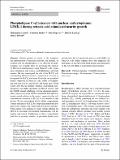Files in this item
Phospholipase C-η2 interacts with nuclear and cytoplasmic LIMK-1 during retinoic acid-stimulated neurite growth
Item metadata
| dc.contributor.author | Arastoo, Mohammed | |
| dc.contributor.author | Hacker, Christian | |
| dc.contributor.author | Popovics, Petra | |
| dc.contributor.author | Lucocq, John Milton | |
| dc.contributor.author | Stewart, Alan J. | |
| dc.date.accessioned | 2015-12-22T16:40:03Z | |
| dc.date.available | 2015-12-22T16:40:03Z | |
| dc.date.issued | 2016-02 | |
| dc.identifier | 233941196 | |
| dc.identifier | 04662c9d-1c1b-4a0f-8e97-a3f2e21f3b5b | |
| dc.identifier | 84957848929 | |
| dc.identifier | 000369328300004 | |
| dc.identifier.citation | Arastoo , M , Hacker , C , Popovics , P , Lucocq , J M & Stewart , A J 2016 , ' Phospholipase C-η2 interacts with nuclear and cytoplasmic LIMK-1 during retinoic acid-stimulated neurite growth ' , Histochemistry and Cell Biology , vol. 145 , no. 2 , pp. 163-173 . https://doi.org/10.1007/s00418-015-1390-7 | en |
| dc.identifier.issn | 0948-6143 | |
| dc.identifier.other | ORCID: /0000-0003-4580-1840/work/60195805 | |
| dc.identifier.other | ORCID: /0000-0002-5191-0093/work/64361221 | |
| dc.identifier.uri | https://hdl.handle.net/10023/7925 | |
| dc.description | We gratefully acknowledge financial support from the Wellcome Trust (Grant No. WT089803MA to J.M.L.) and the School of Medicine, University of St Andrews. | en |
| dc.description.abstract | Neurite growth is central to the formation and differentiation of functional neurons and recently, an essential role for phospholipase C-η2 (PLCη2) in neuritogenesis was revealed. Here we investigate the function of PLCη2 in neuritogenesis using Neuro2A cells, which upon stimulation with retinoic acid differentiate and form neurites. We first investigated the role of the PLCη2 calcium-binding EF-hand domain, a domain that is known to be required for calcium-dependent PLCη2 activation. To do this we quantified neurite outgrowth in Neuro2A cells, stably overexpressing wild-type PLCη2 and D256A (EF-hand) and H460Q (active site) PLCη2 mutants. Retinoic acid-induced neuritogenesis was highly dependent on PLCη2 activity, with the H460Q mutant exhibiting a strong dominant-negative effect. Expression of the D256A mutant had little effect on neurite growth relative to the control, suggesting that calcium-directed activation of PLCη2 is not essential to this process. We next investigated which cellular compartments contain endogenous PLCη2 by comparing immuno-electron microscopy signals over control and knockdown cell lines. When signals were analyzed to reveal specific labelling for PLCη2, it was found to be localized predominantly over the nucleus and cytosol. Furthermore in these compartments (and also in growing neurites), a proximity ligand assay revealed that PLCη2 specifically interacts with LIMK-1 in Neuro2A cells. Taken together, these data emphasize the importance of PLCη2 and its articulation with LIMK-1 in regulating neuritogenesis. | |
| dc.format.extent | 944985 | |
| dc.language.iso | eng | |
| dc.relation.ispartof | Histochemistry and Cell Biology | en |
| dc.subject | Calcium signaling | en |
| dc.subject | Cell differentiation | en |
| dc.subject | Electron microscopy | en |
| dc.subject | Neuritogenesis | en |
| dc.subject | Protein-protein interaction | en |
| dc.subject | RB Pathology | en |
| dc.subject | QH301 Biology | en |
| dc.subject | NDAS | en |
| dc.subject.lcc | RB | en |
| dc.subject.lcc | QH301 | en |
| dc.title | Phospholipase C-η2 interacts with nuclear and cytoplasmic LIMK-1 during retinoic acid-stimulated neurite growth | en |
| dc.type | Journal article | en |
| dc.contributor.sponsor | The Wellcome Trust | en |
| dc.contributor.institution | University of St Andrews. School of Medicine | en |
| dc.contributor.institution | University of St Andrews. Institute of Behavioural and Neural Sciences | en |
| dc.contributor.institution | University of St Andrews. Biomedical Sciences Research Complex | en |
| dc.identifier.doi | 10.1007/s00418-015-1390-7 | |
| dc.description.status | Peer reviewed | en |
| dc.identifier.grantnumber | 089803/B/09/Z | en |
This item appears in the following Collection(s)
Items in the St Andrews Research Repository are protected by copyright, with all rights reserved, unless otherwise indicated.

